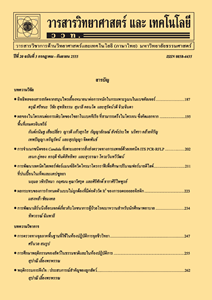การพยากรณ์ความน่าจะเป็นการไม่สำเร็จการศึกษาภายใน 4 ปี ภายใต้ตัวแบบลอจิต 2 กลุ่ม และตัวแบบลอจิตออดส์เชิงสัดส่วน
Main Article Content
Abstract
บทคัดย่อ
ปัจจุบันบัณฑิตปริญญาตรีในไทยมีจำนวนมากขึ้น แต่ยังมีปัญหาที่บัณฑิตใช้เวลาศึกษาเกินหลักสูตร 4 ปี ซึ่งอาจทำให้สูญเสียงบประมาณและโอกาสการก้าวหน้า งานวิจัยนี้ศึกษาอิทธิพลของปัจจัยเสี่ยงต่าง ๆ เพื่อนำมาพยากรณ์ความน่าจะเป็นการไม่สำเร็จการศึกษาภายใน 4 ปี โดยอาศัยข้อมูลการสำรวจประชากร 516 คนด้วยตัวอย่าง 258 คน จากนักศึกษาชั้นปีที่ 4 ปีการศึกษา 2556 คณะวิทยาศาสตร์ มหาวิทยาลัยศิลปากร ภายใต้แผนแบบการเลือกตัวอย่างแบบมีระบบ (systematic sampling design) และอาศัยตัวแบบเชิงสถิติในการวิเคราะห์ข้อมูล คือ ตัวแบบลอจิต 2 กลุ่ม ที่ตัวแปรตอบสนองไม่มีอันดับ คือ ไม่สำเร็จการศึกษาและสำเร็จการศึกษา และตัวแบบลอจิตออดส์เชิงสัดส่วน (proportional odds logit model) 3 กลุ่มที่ตัวแปรตอบสนองมี 3 อันดับ คือ ไม่สำเร็จการศึกษา สำเร็จการศึกษาตามเกณฑ์ และสำเร็จการศึกษาเกียรตินิยม ส่วนปัจจัยเสี่ยงศึกษาจากวรรณกรรมที่เกี่ยวข้องมี 30 ปัจจัย (x1-x30) ผลของการวิจัยพบว่าตัวแบบมีภาวะสารูปดีและมี 4 ปัจจัยเสี่ยง ที่ส่งผลกระทบอย่างมีนัยสำคัญเชิงสถิติที่ 0.05 คือ x18, x21, x27 และ x29 ผลการพยากรณ์ความน่าจะเป็นด้วยตัวแบบลอจิต 2 กลุ่ม เช่น นักศึกษาคนหนึ่งมีพฤติกรรมเสียเวลาไปกับการเที่ยวเตร่และเรื่องไม่ใช่การเรียนในระดับมาก (x18(1)) และเมื่ออ่านหนังสือเสร็จข้าพเจ้าจะไม่บันทึกสรุปสั้น ๆ (x27) พบว่าความน่าจะเป็นไม่สำเร็จการศึกษาเท่ากับ 0.190 ถ้าพยากรณ์นักศึกษาคนหนึ่งที่มีพฤติกรรมเสียเวลาไปกับการเที่ยวเตร่และเรื่องไม่ใช่การเรียนในระดับปานกลาง (x18(2)) และเมื่ออ่านหนังสือเสร็จข้าพเจ้าจะไม่บันทึกสรุปสั้น ๆ (x27) ความน่าจะเป็นที่นักศึกษาไม่สำเร็จการศึกษาจะลดลงได้เป็น 0.129 ส่วนการพยากรณ์ความน่าจะเป็นด้วยตัวแบบลอจิตออดส์เชิงสัดส่วน 3 กลุ่ม เช่น นักศึกษาคนหนึ่งเสียเวลาไปกับการเที่ยวเตร่และเรื่องไม่ใช่การเรียนในระดับมาก (x18(1)) เมื่ออาจารย์มอบหมายให้ค้นคว้าหรืออ่านหนังสือเพิ่มเติมข้าพเจ้าจะรีบเข้าห้องสมุดทันทีที่มีเวลาว่างในระดับมาก (x21(1)) เมื่ออ่านหนังสือเสร็จข้าพเจ้ามักจะไม่บันทึกสรุปสั้น ๆ (x27) และการทบทวนบทเรียนข้าพเจ้าไม่ใช้วิธีตั้งคำถามให้ตนเองมากกว่าการอ่านหนังสือไปเรื่อย ๆ (x29) พบว่าความน่าจะเป็นไม่สำเร็จการศึกษาเท่ากับ 0.085 ความน่าจะเป็นสำเร็จการศึกษาตามเกณฑ์เท่ากับ 0.860 และความน่าจะเป็นสำเร็จการศึกษาเกียรตินิยมเท่ากับ 0.055 ตามลำดับ และถ้าพยากรณ์นักศึกษาคนหนึ่งเสียเวลาไปกับการเที่ยวเตร่และเรื่องไม่ใช่การเรียนในระดับปานกลาง (x18(2)) เมื่ออาจารย์มอบหมายให้ค้นคว้าหรืออ่านหนังสือเพิ่มเติมข้าพเจ้าจะรีบเข้าห้องสมุดทันทีที่มีเวลาว่างจากการเรียนในระดับปานกลาง (x21(2)) เมื่ออ่านหนังสือเสร็จข้าพเจ้ามักจะไม่บันทึกสรุปสั้น ๆ (x27) และในการทบทวนบทเรียนข้าพเจ้าไม่ใช้วิธีตั้งคำถามให้ตนเองมากกว่าการอ่านหนังสือไปเรื่อย ๆ (x29) ความน่าจะเป็นไม่สำเร็จการศึกษาจะเท่ากับ 0.075 ความน่าจะเป็นสำเร็จการศึกษาตามเกณฑ์เท่ากับ 0.865 และความน่าจะเป็นสำเร็จการศึกษาเกียรตินิยมเท่ากับ 0.06 ตามลำดับ สรุปได้ว่า ถ้านักศึกษามีปัจจัยเสี่ยงที่พบข้างต้นในระดับน้อยลง ความน่าจะเป็นไม่สำเร็จภายใน 4 ปี จะมีแนวโน้มลดลงด้วย
คำสำคัญ: ปัจจัยเสี่ยงของการศึกษาในมหาวิทยาลัย; การสำเร็จการศึกษา; เกียรตินิยม; ตัวแบบเชิงสถิติ
Abstract
Thai bachelors are currently increasing; however, there are several graduates of failing to graduate within 4 years. This may potentially cause either over budgets or loosing opportunity in life. This research investigates the effective risk factors and the probability prediction of level of failing to graduate in 2 cases. Case 1, nominal two grouped responses: fail to graduate and graduate. Case 2, ordinal three grouped responses: fail graduate, graduate, and honor graduate. Risk factors from relevant literature review consist of 30 factors (x1-x30). The sample of 258 fourth-year students were randomly selected using systematic sampling from 516 population units of the fourth-year science students, Silpakorn University in the academic year 2013. The results show that models’ goodness-of-fit tests are significant at 0.05 with four risk factors, so that they are suited to use in models for prediction a probability. In forecasting the probability of failing to graduate using the dichotomous logit model, when a student who has level of his loaf time at high level (x18(1)), and when I completed reading book, I didn’t do any short summary (x27), is found to be 0.190. Similarly when his loaf time is at moderate level (x18(2)), the probability is decreased to be 0.129. The forecasting probability of failing to graduate using the proportional odds logit model is equal to 0.08 when a student has level of his loaf time at high level (x18(1)), when the lecturer assigned me to research or read more books, I will rush to the library as soon as I have free time at high level (x21(1)), when I completed reading book, I didn’t do any short summary (x27) and when reviewing the lessons I didn’t have self-questioning rather than only do my reading (x29), which leading to the probability of graduate is 0.86, and the probability of honor graduate is 0.06, respectively. Alternatively, the forecasting probability when a student has level of his loaf time at moderate level (x18(2)), when the lecturer assigned me to research or read more books, I will rush to the library as soon as I have free time at moderate level (x21(2)), when I completed reading book, I didn’t do any short summary (x27) and when reviewing the lessons I didn’t have self-questioning rather than only reading (x29), is found to be 0.075, and that the forecasting probability of graduate is 0.865, and the probability of honor graduate is 0.06, respectively. Hence, in conclusion, if a lower level of the risk factors the student can perform, a smaller probability of failing to graduate within 4 years is probably achieved.
Keywords: risk factors in education; university graduate; honor graduate; statistical models


